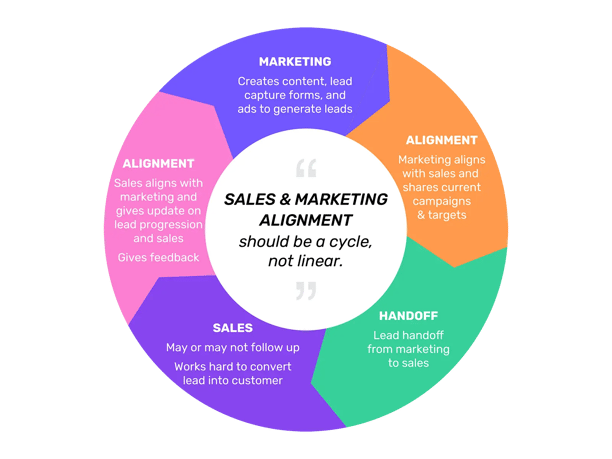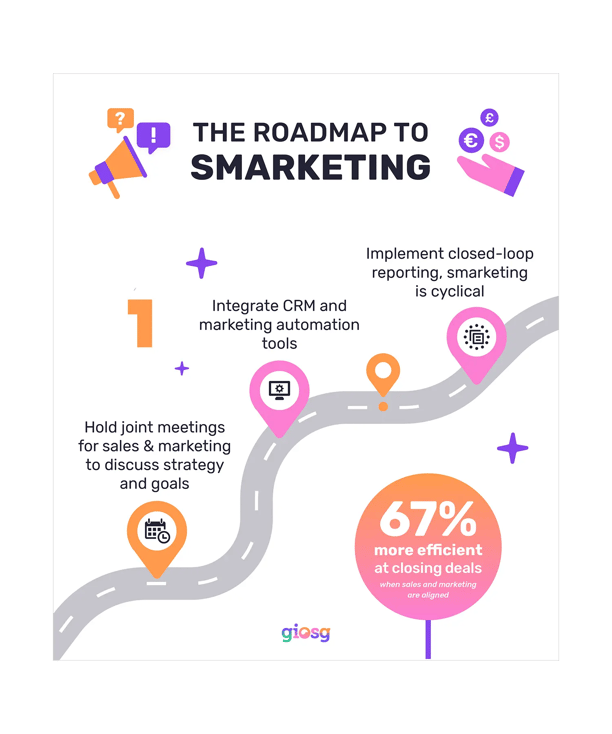When you look at your sales and marketing departments, does each department work harmoniously with one another sharing data, leads, and feedback without any prompting needed?
Or do they have their blinders up racing towards accomplishing their own team’s goals before the end of the quarter?
If you are the latter, you may be suffering from sales and marketing misalignment. And, if you are the former, you may be a smarketing hero.
This smarketing guide will show you exactly how to break through the traditional barriers keeping you from sales and marketing alignment. You'll want to takes notes on these tips to keep siloed departments out of sight.

Why You Should Care about Smarketing
"Smarketing” is a term used to describe sales and marketing alignment; an alignment that often leads to top-line growth.
Consider your team winning in smarketing when the traditional silos of each team are no longer hindering growth and collaboration. In the best-case scenario, those silos are actually demolished.
You’ll want to adopt the best practices for smarketing sooner rather than later because companies with strong sales and marketing alignment are
- 67% more efficient at closing deals.
- achieving 20% annual revenue growth
- seeing 208% growth in marketing revenue
Integrating sales and marketing processes doesn’t happen overnight, but don’t worry, we’ll help you build a secure foundation for smarketing that drives revenue.
Here's what we'll cover:
1. What is sales and marketing alignment?2. Why is aligning sales and marketing difficult?
3. Benefits of aligning sales and marketing
4. Practical tips to align sales and marketing
5. Roadmap to smarketing
6. Assess the strength of your smarketing
What is sales and marketing alignment?
If you guessed that the term smarketing comes from the combining of the words sales+marketing, you’re exactly right! Coming up with this term seemed easy enough, so let’s make defining and implementing smarketing just as easy. We know we want to align our sales and marketing team, but what is the axis point we are aligning to?
First and foremost, both teams have to rally around the same big-picture goal. In most companies, that goal is increasing sales and revenue. With a common goal established, cooperation between both sales and marketing is vital to achieving it.
You can no longer be satisfied with the idea that marketing does its half and has its own goals, while sales do their half and stick to their own goals.
This traditional divide explains why 55% of marketers aren’t sure what assets are most useful for their sales colleagues.
To optimise sales and marketing returns, you have to stop thinking of the relationship like a relay race.
For example, marketing does their hard work and attracts the customer, then hands the baton off to sales and it's their turn to do the hard work and finish off the race. This would be a bronze medal performance at best with this type of strategy.
Instead, you should think of the relationship between marketing and sales as a cycle.
Marketing should know what sales does after the handoff and learn from it, and sales should know what marketing does before the handoff, and, you guessed it, learn from it.

If your only interaction is the handoff itself, you're missing valuable insights on both sides that could help the other leverage in attracting or closing leads.
Why is aligning sales and marketing difficult?
Before we jump into the proven benefits of smarketing, we need to know what type of hurdles are preventing us from smooth sales and marketing alignment.
4 major roadblocks make aligning sales and marketing teams difficult:
- Not talking about money
- Not using closed-loop reporting
- Being hesitant to give feedback
- Using different terminology across teams
Smarketing Mistake #1 Not talking about money
If you avoid talking about money (more specifically revenue) across sales and marketing teams, you are ignoring your main goal.
Sure, sales teams often talk about revenue, average deal size, pipeline and all things money-related, but it is helpful for the marketing team to be in on this conversation too.
When marketing is aware of how sales performance is measured, they can better assess which marketing efforts are fruitful or bare. This awareness also leads to better maintenance of the budget.
Companies that don’t have sales and marketing alignment are more than twice as likely to report budget cuts to sales and/or marketing.
Smarketing Mistake #2 Not using closed-loop reporting
Does your marketing department know what happens to a lead after it is in sales’ hands?
Does your sales department understand the prior web behaviour that qualified the prospect as a lead?
If the answer is no to either of these, you’re operating in an open loop.
Closing the loop for smarketing means that marketing and sales would share the same reporting data. Cross-functional team communication in reporting would ensure transparency with lead intelligence between sales and marketing.
And when both teams are accountable for the data they share, it forces teams to follow systems correctly and report more accurately.
There are at least two things you absolutely need to be looking at in closed-loop reporting:
- customers by marketing source
- conversion assists.
When data is shared that illuminates this information, you also understand your customer more thoroughly. In addition, this helps marketing know which lead generation strategies are working best.
Sales and marketing teams that are well-aligned and open to sharing data lead to 36% higher customer retention.

Smarketing Mistake #3 Being Hesitant to Give Feedback
Once your data is transparent and accessible to both teams, the next step is to be open with communication and feedback. Giving and receiving feedback across teams should not be a faux pas.
Traditionally, there could be underlying tension because of what one team thinks the other should be performing better at.
For example, 23% of sales want better quality leads from marketing, while 30% of marketing wants consistent use of systems from sales. But this type of feedback isn't always based on data, and it often leads to finger-pointing.
The feedback both teams should be confident in dishing out needs to be backed by the cold, hard facts. Additionally, feedback that relates back to the company’s goals also gives you the green light to speak up.
This type of data-based feedback is only possible if you’re not stuck on the previously-mentioned mistake #2, and are using closed-loop reporting.
Smarketing Mistake #4 Using Different Terminology Across Teams
If you haven’t caught on by now, lapses in communication are the main problem holding you back from sales and marketing alignment.
If your sales and marketing team use different terminology for your products, different definitions of what qualifies a lead, or holds unrealistic expectations for the other team, it’s time to fix this.
Let’s align terminology for smarketing in a few easy steps:
- Create a company-wide glossary for consistent terminology
- Define the levels of the sales funnel and what makes a qualified lead
- Implement a Service Level Agreement (SLA) to establish expectations of what marketing and sales will do for each other.

Benefits of Aligning Sales and Marketing
Aligning sales and marketing rewards you with more than just smoothing out communication gaps. 98% of B2B organisations agree that alignment is critical to business success.
Businesses that have strong sales and marketing alignment are attributing the following results to smarketing:
- 32% increase in year-over-year (YoY) revenue growth
- 38% higher sales win rates
- 27% faster profit growth
- 20% higher customer lifetime value
- Less-wasted work (compared to 60 to 70% of content being left unused due to sales not knowing it exists or not finding it useful)
- Better integrated, centralised data systems
- Better perspective on marketing ROI
When sales and marketing are aligned, you can move leads through your pipeline faster.
Practical Tips for Sales and Marketing Alignment
1. Sales and marketing should meet frequently
There seems to be some disconnect between how often sales and marketing believe they are currently meeting. 26% of salespeople say they never meet with marketing to discuss the pipeline, while 31% of marketers say that they meet with sales weekly to discuss the pipeline.
There shouldn’t be any ambiguity about the frequency of meetings.
Official recurring meetings should take place between sales and marketing at least every 6 weeks to:
- talk about goals
- outline strategy
- define common terms
- review past, present, and current campaigns
- openly discuss challenges
For weekly communication, sales and marketing should utilise digital communication like Slack, email, or other communication tools. If the two departments have been working in isolation, working on some team-building activities like corporate trips, lunches or meet and greets will help strengthen interpersonal relations and communications.

2. Sales and marketing need to work together and even sit together
Many businesses can talk the talk, but how many will walk the talk? To further encourage sales and marketing alignment, you should also align your teams in the physical space as well.
Here are a few ways that both teams benefit from working and sitting together in the office:
- marketing can shadow sales calls or demos to reconsider marketing strategies.
- sales have the opportunity to ask marketing about incoming leads.
- sales and marketing gain customer insights by peeking into one another’s processes
3. Use Integrated marketing and sales tools
Combining your marketing and sales tools will give you the benefit of having all of your data in one place. When your data is divided among several different tools that are not integrated, you are reverting back to the siloed departments of marketing versus sales.
Here are some benefits of integrated marketing and sales tools and combined data:
- Holistic understanding of the customer journey
- Two perspectives of customer feedback
- Easier to collaborate on projects
You can either integrate marketing and sales tools by adopting an all-in-one CRM software that meets both the needs of marketing and sales. Or, you can integrate the marketing automation tools and sales automation tools you already have in place.
68% of businesses use automation in some way, so aligning your automation tools can help you achieve the best results from them.
4. Understand the relationship between sales and marketing is not linear
As mentioned previously, to align sales and marketing, you have to focus on more than just the lead handoff.
Deliverables, data, and structuring are needed at all levels of the funnel by both teams to ensure smarketing alignment leads to revenue growth.
Best practices to keep this symbiotic relationship at the top of your smarketing are:
- having an SLA to establish agreed deliverables from both teams to help form a mutually beneficial partnership
- sharing analysis reports and diverse data helps form a complete view of efforts rather than an emotion-based view
- continuously facilitating your team communication to meet the needs of both sales and marketing
The roadmap to smarketing

Assess the strength of your smarketing
Before you start restructuring to have smarketing within your organisation, let’s assess where your company stands now on the spectrum of sales and marketing alignment.
P.S. You’re in good company if your sales and marketing team are at least somewhat aligned. 81% of companies that beat their revenue goal attribute this to being somewhat or completely aligned.
1) Completely aligned
The top of the top. “Completely aligned” sales and marketing teams will have:
- Common goals
- Monthly meetings
- A clear definition for SQL
- Integrated system to access data for sales and marketing performance
- An appreciation for feedback from the other team
- A complete view of the customer journey
- Shared internal communication channels
2) Somewhat aligned
Marketing and sales alignment for a “somewhat aligned” company will at least have these things:
- Common goals
- Meetings when necessary
- Open to feedback
- Internal communication channels

3) Somewhat misaligned
A somewhat misaligned sales and marketing team will have these roadblocks slowing them down from alignment:
- Meetings only initiated by one party
- Different definitions of what qualifies a lead
- Creating content without a clear objective
4) Completely misaligned
If you have the following red flags between your sales and marketing team, you may be completely misaligned:
- Focused only on departmental goals
- No interactions or exchange of feedback between teams
- Separate marketing automation and CRM tools
- Unaware of what happens before or after their key duties
- Lead blaming (ie accusing the other of poor quality leads or lack of follow-up)
A Free Sales and Marketing Alignment Assessment
How to tell if your sales and marketing are completely aligned? Assess your organisation’s structure with our free sales and marketing alignment assessment.
